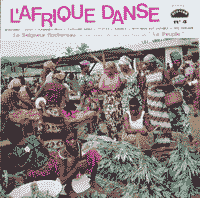
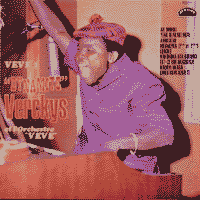
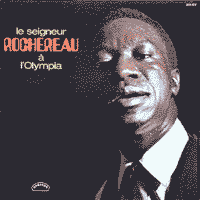
THE AFRICAN 360 SERIES
(DISTRIBUTED BY SONODISC): AN OVERVIEW
After two decades of listening to and collecting African music I have come to look on certain record labels as reliable and others as so excellent as to inspire acquisitive lust on sight. Among the former are the Popular African Music series from Frankfurt, Germany, and Dakar Sound published in Holland. Among the latter are Editions Syliphone (Conakry) which issued Malian and Guinean music, Aboudou Lassissi's Sacodis label from Abidjan and the French Pathé-Marconi label (a subsidiary of EMI). Its Hit Parade Africain discs were perhaps the earliest anthologies of popular African music released in Europe. In the nineteen-seventies, many quality recordings of classic Congolese bands were issued in the AFRICAN 360 series, distributed by SonoDisc of Paris. This was another series I began to collect seriously as it contained my "soul" music: Congolese pop of the sixties and seventies. The lack of recording information, beyond titles and composers of songs and occasionally licensing, frustrates any attempts at scholarship but foregrounds the music, which is consistently great.
The attitude of the label was very much like that seen in the "Colonie Belge" genre of Congolese paintings which showed the superior whites treating the Africans like wayward children, humiliating and punishing them. (In Congo in 1983 I heard many stories like that from a porter climbing Mount Virunga, the third highest mountain in Africa. When we got to the base camp for the summit we found iron beds in the hut. He told me that he had helped to carry them up as a lad, and was threatened with severe beatings if he dropped anything.) This brutal attitude even permeates the music where the 360 series was concerned. A fragile and rare treasure of the world's music was bungled, mishandled and tossed off by the French publishers. Clearly they didn't give un crotte.
The oldest archive of Congolese music in Europe (dating from the 1950s) belonged to Editions Ngoma, who recorded in Léopoldville but pressed their records in France. According to (Congolese music historian/biographer) Vincent Luttman, around 1961 Fonior (a subsidiary of the Decca Records empire) began issuing 45s of the orchestra African Jazz on Decca for European and African (non-Congolese) release. This deal was set up by Grand Kalle -- where Fonior paid for and held the recordings, but granted Kalle license for release in Congo under his own editions label 'Surboum AJ.' The European- and Congolese-pressed editions differed, using different artwork and catalogue numbers throughout. Around 1963-65 Decca also began reissuing some of these 45T as a series of 4 track 45T EPs. At this time the only artists to appear on the European editions produced by Fonior/Decca were African Jazz, OK Jazz, African Fiesta, Loup Jazz and Pierre Rasins (Antilles-based artist).
By 1967-8 Fonior (by then semi-independent of Decca) were distributing Congolese records on many smaller Congolese labels (Editions Boboto, Paka Siye, etc) and these later became the mainstay of the early African 45T catalogue (being repressed and re-issued as the 90xxxx 45T series from around 1968-ish on. These re-issues were primarily made for European-Francophone markets and African (non-Congo) distribution.
The 360 series of LP releases began to appear from around 1966-67 (the first ten releases only -- with the series beginning properly from around 1969), and were either LP's licensed directly from Congolese labels (see Izeidi below) or were compiled (in later releases) from previously licensed 45Ts taken from the labels 90 series.
When the once mighty Ngoma label collapsed in the early 1970s, Fonior secured the rights to their catalogue and began integrating previous Ngoma product into their African (LP & 45T) series, repackaging them and issuing them with new Editions African 90xxx or 360xxx catalogue numbers.
The African 360 series of LPs also added to their catalog from the (Fonior-owned) Fiesta label. Fiesta was begun in the early 1970's (1971-73) and concentrated on releasing non-Congolese 33T including a number of Camerounian artists (Manu Dibango's SOUL MAKOSSA being their most famous 45T). Congolese artists however did sometimes appear on editions Fiesta 45T (as did a number of Middle-Eastern artists) including many works by both OK Jazz (licensed from Franco's Editions Populaire) and Negro Succes.
As stated above, back in 1961 Decca licensed their Congolese recordings to Fonior in Brussels for sale in Belgium. Fonior also sometimes pressed records for Loningisa and Esengo.
According to Gary Stewart, in RUMBA ON THE RIVER, the technically superior Fonior studios in Brussels became the site of pilgrimage for African artists, beginning with Kalle and African Jazz, with whom Manu recorded his first sessions. The musicians would go into the studio and work until they had recorded over forty songs. Some had already been composed, but a great many were written in the studio. Manu's biography (7 KILOS OF COFFEE) gives a unique account of this spontaneous composition and recording process. The pay for 40 songs was usually about $200 to share among band members who would sometimes collapse from hunger or fatigue during these long, arduous sessions.
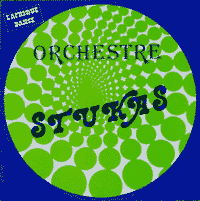
As the 1960's progressed into the 1970s, the once profitable Decca recording empire began to decline. By the mid-1970s the decline became terminal. Fonior struggled on, licensing product from the 'new wave' of Congolese artists (Veve, Zaiko, LipuaLipua, Stukas, etc) as well as retaining links with the old guard (Franco/Rochereau/Izeidi, etc), but by the late 1970s the African catalogue already contained many gaps. The production of African 45T seems to have ended around 1978, although the LP series continued. In those later years poor pressing/mastering facilities also meant that when 45T records were pressed/repressed there were many faulty discs -- this probably accounts for the decline and abandon of the 45T singles catalogue. Finally Fonior went into bankruptcy in 1981 and its entire catalogue was purchased by Sonodisc for a nominal fee.
Sonodisc was formed in 1970 by two former employees of Ngoma (the Congolese label that operated a pressing plant in France), Marcel Perse and Michel David. They left Ngoma with contacts and even recordings but mainly acted as distributors of Umm Kalthum records from Egypt and some from the Caribbean. When the Fonior catalogue went to Sonodisc for a pittance, Franco, Tabu Ley & Verckys sued to regain control over their recordings but were over-ruled in court. Token payments were made to them, but no other African artist ever received a sou for their music which was now in the hands of Sonodisc.
Vincent Luttman writes, "Another interesting note is that Roger Izeidi, after terminating his career as a musician in the late 1960s, was instrumental in the original setting up of this series and a large number of the early LP releases were licensed directly from him via labels he owned or had shares in such as Editions Vita, Hit Parade, Isa, Flash, Tchenza etc."
The AFRICAN 360 series has two main sub-categories: L'Afrique Danse and Les Merveilles du Passé. Both focus on mid-60s to mid-70s Zairean popular music. There is also a 425 series of modern releases. Anyone interested in the development of Zairean popular music will know the so-called "Youth bands" Zaiko Langa Langa and Viva La Musica whose earliest recordings may be found in the Sono African 425 series, although they released albums on many different labels.
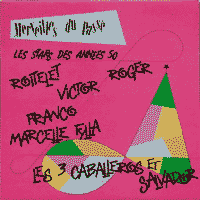
The mainstays of the AFRICAN 360 catalogue are, naturally enough, the most popular artists from Congo (Zaire): "Franco" (Luambo Makiadi), "Docteur Nico" (Kassanda wa Mikalay), "Rochereau" (Tabu Ley Pascal), Kiamuangana Verckys, and Camerounian multi-instrumentalist Manu Dibango. The oldest recordings in the African series are on an album STARS OF THE FIFTIES (360.164), which features Roger Izeidi and the CEFA choir. Roger later sang with "Le Grand Kalle" (Joseph Kabaselle); here he teams up with Roitelet for two songs, "Banga Imana," and "Imana ya Daring," which have lovely harmonies. Roitelet and the CEFA choir render "Tozo na Bozo," a satire on the Belgians with its stirring refrain "Mais mais oui, mais mais non!"
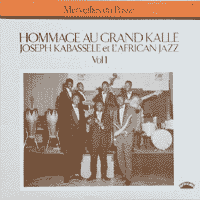
The two volumes of HOMMAGE AU GRAND KALLE (360.142/143), featuring Joseph Kabaselle et l'African Jazz are the earliest recordings of Docteur Nico and his brother Mwamba Déchaud, as well as the legendary Tino Baroza and his lesser-known brother Dicky, and the debut of Tabu Ley Rochereau. The evolution of the mi-solo guitar style pioneered by Déchaud, in which the rhythm guitar doubles the lead guitar in the breaks, can be heard in these important early recordings. "Africa Mokili Mobimba," which leads off volume 1, was covered by Tshala Muana and later Sam Mangwana, after which it became a "standard." Volume 2 has Kabaselle's important "Independance Cha Cha" and covers of songs by Trio Matamoros of Cuba. The two volumes demonstrate the emergence of a Congolese national style from the Cuban rhumba and merengue.
Continuing chronologically, the Merveilles du Passé collection includes the earliest recordings of African Fiesta, the key band that Rochereau & Nico formed after leaving Kabaselle's African Jazz. A curio is the African Team recording of Kabaselle and Manu Dibango (360.017), which shows the band's attempt to urbanize after moving to Paris. The Isaac Hayes-inspired funk sound is heard on songs like "Africa Boogaloo." The African Fiesta recordings from 1962-3 (360.162/163) contain some of my favourite African recordings: Rochereau's "Pesa le Tout" and "Madina" demonstrate his beautiful singing at its peak. Roger Izeidi's "Mobembo Eleki Tata" and "Vivo Africa" are also strong rallying cries for fans of the emergent Congolese pop sound, and the consistently inventive guitar interplay of Nico and Déchaud is thrilling. Les Merveilles du Passé 1965 (360 145, released in 1984), titled KWAMY NICO ROCHEREAU, is quite short but satisfying in its balance of material. The Cuban influence is at its heaviest in songs like "Pablo Gonzales" and "Tuson," and one also hears close imitations of hits by Trio Matamoros and Orchesta Aragon.
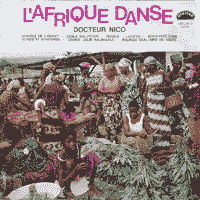
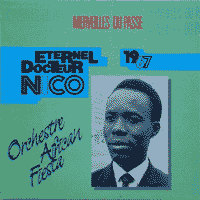
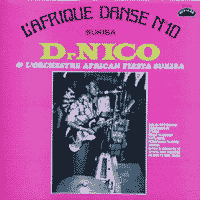
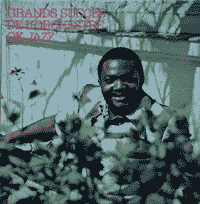
Among the several other Nico recordings in the African series, ETERNEL DOCTEUR NICO 1967 (360 159 green cover) is fabulous, while the companion volume (360 160 pink cover) shows the only weak spot in the Nico canon, where African Fiesta attempts to cover some English pop songs. Imitating Buddy Holly and the Beatles does not look good on Nico, who was a more evolved guitarist. He fares better on rhumba and cha-cha rhythms. Three discs in the Afrique Danse series show the mature style of Nico from 1968 to 1970, including the dance Nico invented -- the Kiri Kiri -- that starts slowly and builds to a smouldering crescendo. L'AFRIQUE DANSE #5 (360.005) features "Mokili ya Nzambe," L'AFRIQUE DANSE #8, VITA (360.011), includes the signature tune "Biantondi Kasanda," a recap of "Merengue President," and another perennial favourite, "Mamu wa Mpoy." L'AFRIQUE DANSE #10, Sukisa (360.024), has "Mokili ya Nzambe," the beautiful ballad "Tu m'as deçu chouchou," and Nico's first lengthy track, "Echantillon ya Pamba." (The latter is also duplicated on 360.020, L'AFRIQUE DANSE #9.) The first African Fiesta recordings, from 1963 (all credited to Roger Izedi), were first issued as VITA 2.000, then African 360.015. "Mobembo Eleki Tata" is outstanding here (as it is on 360.163!). The albums give ambiguous dates, no useful liner notes, and indulge in rampant duplication of the best tracks. Several even have identical jackets. I have three with the same cover photograph, but I suppose the notion of the "set" pertains: collect 'em all.
The prolific Franco & O.K. Jazz are also well represented in the African catalogue. The appropriately named "Authenticité" series collects the band's earliest European recordings, made as 45T for Kalle's Surboum label and released as Surboum OK Jazz. Unfortunately these records, too, often duplicate the best tracks and include a fair bit of filler to extend the number of releases -- a shame since hundreds of Franco recordings, many of them stellar, are on the market. Sadly, a lot of his best material came out only on Nigerian and Kenyan pressings, which leave much to be desired (being badly mastered with a lot of surface noise) and a few of the African releases (e.g., 360.104/105) are poorly recorded. From 1966, L'AFRIQUE DANSE #6 (360.006) shows the trademark guitar/horn interplay of O.K. Jazz is firmly established. Of the many Franco recordings, those from the mid-60s through mid-70s are the strongest. These include Editions Populaires, 10e ANNIVERSAIRE 1965-75 (360.081), AFRICAN PARTY (360.096), AUTHENTICITÉ vol. 5 (360.103, 1975), and two albums with Sam Mangwana from 1974, also from Editions Populaires, that are not great recordings but essential music. The classic Franco albums in this series, both double-record sets, are the cornerstone of any Franco collection: 20e ANNIVERSAIRE (360.082/83) showcases different vocalists, including Wuta-Mayi and Youlou Mabiala, and shows the strengths of the big band that TPOK Jazz had become by the mid-70s. The other crucial album is LIVE RECORDING OF THE AFRO-EUROPEAN TOUR (360.114/115). Actually it's not a live recording but a studio recording (part of it can be found on 360.108) with applause grafted on. Nevertheless, the twelve tracks are each eight to ten minutes long, and the band stretches out with its incredible "one mind." This set includes some fierce guitar work, fine harmony singing, and great sax.
Rochereau, too, fares best on his longer albums, like his incredible LIVE AT OLYMPIA, PARIS (360.028/9). Another two volume issue, LIVE AT FESTAC in Lagos, from 1977 (360.097/98) is a truly legendary recording with members of the Stukas in his band and Isaac Hayes horn riffs as a fanfare. Four albums comprise the BELLE EPOQUE of Rochereau, and the last pair of these (360.149/50) with Sam Mangwana are the most compelling. Rochereau's recordings with African-Fiesta National (after he split from Nico) are found on LES MERVEILLES DU PASSÉ #4 (360.008), a wonderful album from 1969 that includes several classic songs. Mangwana's mature work is not represented in the series, but his early work with Les Grand Maquisards can be heard on SONORA (360.031, and 360.166). Equally fine is the post-Mangwana MAQUISARDS disc (360.155) which includes Ntessa Dalienst's early songs "Maria Mboka" and "Biki," recorded before he moved to O.K. Jazz.
Two other seminal bands of the post-Independence era are Brazzaville's Bantous de la Capitale and Orchestre Bella Bella. Both have retrospective collections in the 360 series. The Bantous' early 1960s sides are collected in three volumes of the LES MERVEILLES DU PASSÉ series. My favourite (360.154) comes from 1963 and includes Jean-Serge Essous's pulsing sax number "Tokumisa Conga."
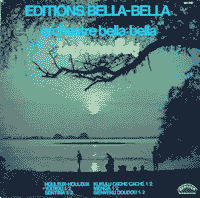
Bella Bella's extended singles from the mid-70s are gathered on 360.064 and 360.093. Both are fine compilations, though the recording quality is a little rough in places. Bella Bella recorded with Kiamuangana Verckys, and several of his solo and other projects are captured on vinyl in this series. His first album DYNAMITE VERCKYS (360.016) is a boisterous, outrageous scorcher. The uncredited vocals are by the group featuring Loko Massengo known as Trio Madjesi. Verckys' Orchestre Vévé is revisited on 360 106 from the late 70s. A less well-known band from Verckys' stable (most of them have double-barreled names) is ORCHESTRE LIPUA-LIPUA (360.063), which included the now-famous singer Nyboma Muan-Dido of Quatre Etoiles, unfortunately a "lo-fi" recording. L'AFRIQUE DANSE AVEC SAKUMUNA (360.101) presents some of the same bands in mono in a better recording. Lipua-Lipua is represented, along with Nyboma's later group, Les Kamales.

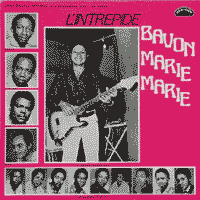
Reaching back into the late '60s again we find LES MERVEILLES DU PASSÉ 1968/69 featuring L'Orchestre Cobantou de Dewayon (360.165), originally on the Londendé label. A much earlier version of this group, Watam, included a youthful Franco and was one of the first bands to electrify Congolese folk music. This is a soulful album with great sax. Johnny Bokelo's group Conga Succès is well represented in the compilation albums and has a reprise on L'AFRIQUE DANSE (360.014).
Another of the classic early rhumba bands, Orchestre Negro Succès, is featured on some of the most magical recordings in the series. 360.013 shows them in their later incarnation. Franklin Boukaka's 1967 collection features his early Negro Band contributions, as well as Cercul Jazz. Another of the absolute classics on the label is the memorial album for Franco's younger brother, L'INTREPIDE BAVON MARIE MARIE (360.023), showcasing a number of his biggest hits with Negro Succes. The influence of James Brown and the Famous Flames is clear in the unexpected exhortations in English, but the bleating sax is pure early rhumba.
The Zairean "Youth bands" have been around twenty years. Still, they are considered the "new wave" of Post-Franco innovators, relying on propulsive percussion and more guitars (hard to envision), and replacing elaborate horn arrangements with a solid wall of contrapuntal guitars. Despite their fashion-dandy poses, they are still concerned with the folk roots of their music. Zaiko Langa Langa became the most famous, though Viva La Musica is perhaps the best splinter group. 360.092 is devoted to six early singles of the group, which at that time included Papa Wemba on vocals and Evoloko Jocker on guitar. The first "post-split" recordings from the late 70s are on 360.117, another crucial collection. After this the introduction of synthesizers makes many of the Langa Langa Clan recordings unlistenable.
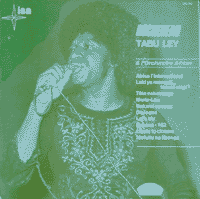
Neophytes may want to start with the anthologies to find what strikes their fancy. One caveat: the best songs of a group are often on a compilation and repeated on a solo album. The AFRIQUE DANSE series has some gems and a few disappointments. Despite the impressive line-up, I wasn't thrilled with 360.050; 360.061 on the other hand had some unknowns, like Orchestres Macchi, Cavacha, and Sec-Sec, that are great. L'AFRIQUE DANSE #7 has a side of Johnny Bokelo and one of his equally talented brother, Dewayon. This is a fine pairing, and the album includes some of their biggest hits. But it's to the first three works in the series (360.001/2/3) that I return continually for the fine mix of bands: le Seigneur Rochereau and le Grand Kalle (Joseph Kabaselle), surprise appearances by Orchestres Los Angel, Conga Succes, and a heavy rotation of O.K. Jazz keep my turntable hot and hopping.
***
PART TWO: THE 365 CD SERIES
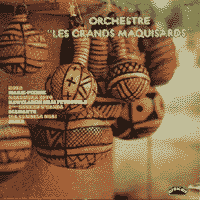
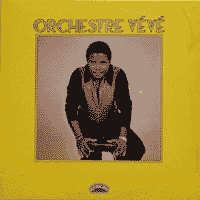
The Sonodisc African series was issued on LP from 1966 to 1987, and totaled 168 volumes. A complete discography can be seen here. Not all the advertised numbers appeared. I have 89 of the LPs, and perhaps around 120 were issued in actuality.
In 1991 Sonodisc began to repackage the series on CD as the 365 series. They used LES MERVEILLES DU PASSÉ as the main name and reissued selected items from their catalogue. This was complicated by several factors. They didn't clearly own the rights to the music (the Franco estate is even now in dispute with them, although Next music, current owners of the Sono catalogue seem to have thrown in the towel yet still without releasing the master tapes) & they became even more cavalier in their sloppy handling of the cultural patrimony of the Congo. Songs shifted about again, sometimes reappearing on different CDs under different names or more often mis-spelled, but more seriously, at other times mastered at the wrong speed. Quite often they dropped the needle and burned a CD. Some of the 45s they had 'inherited' from Fonior now also turned up on their CDs. They seemed to grab at any recordings they could get their hands on. The most egregious example of this occurs on CDS 36529 FRANCO & L'OK JAZZ 1969/71. According to Franco biographer Graeme Ewens, who told me the story, a friend of his found some Franco 45s on a barrow in a London street market and bought them all. He made a cassette of the tunes and sent it to Ewens who in turn copied the cassette and forwarded it to Franco's manager. Next thing he knew it appeared as a Sono CD (in the same sequence) with no explanation. It's a great album and I am glad it is in print, but it bothers me that no one made the effort to a) find the original tapes, or b) borrow the actual 45s in order to re-record and de-click them, and c) acknowledge the source, let alone d) provide some context for the listener.
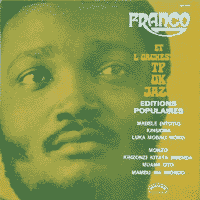
However, this was the Sono attitude: they assumed Africans would not complain and white fans are only too grateful to hear this music at all. But compare the approach of RetroAfric, a London-based label, which goes to great length to get permission to issue the music and also documents it as thoroughly as possible. When I worked at Round World Music in San Francisco in the 1980s and 90s I thought about getting a rubber stamp made reading "What are you looking in here for?" and stamping it on all the blank insides of the Sono CDs.
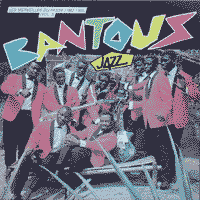
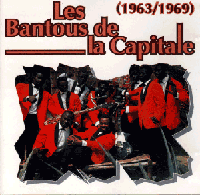
That SonoDisc mislaid or lost original artwork is obvious from cases like CD 36527 LES BANTOUS DE LA CAPITALE 1963/69. The first four tracks are from 360.154 Bantous 1963. However Sonodisc couldn't find the artwork they wanted: a photo of the band in red dinner jackets that had been used on the covers of THREE albums: MERVEILLES DU PASSE 1962-64 (Sono 360.146-8). So they rescanned it (darker) and used the cropped image which had been cut into with some bad jagged type on the three LPs. The result looks dreadful. After releasing about 100 CDs, SONO seems to have gone out of business about 1998 and their catalogue offered for sale for a million dollars.
Now Glenn Succes, and another European label, Ngoyarto, are recovering some of the precious material. Again there are serious questions of ownership in the recordings. Ngoyarto are inevitably duplicating some of the Sono stuff (doubtless lifted straight off their CDs) and are also guilty of egregiously gouging the market: the Ngoyarto Orchestre Bella Bella series came out in five CDs (NG28-32). They were not cheap, but I had to have them. Then they deleted them and re-released five new CDs with the tracks in different order and of course a few added ones. They did the same with CDs of Viva la Musica and Ntesa Dalienst. NG012 THE VERY BEST OF NTESA DALIENST has six tracks while they doubled that on the reissue NG078. Their FRANCO & SAM MANGWANA issues overlap those done by SonoDisc.
Apparently Ngoyarto pays one-time mechanical rights to the artists for reissue of their music. In the case of small Congolese labels, who sent their master tapes to France to be pressed, many of the small ones disappeared or probably only had one-time rights to the music. The problem for musicians is collecting their due, though the labels can claim that their problem is finding the musicians.
In 1999 Stern's announced the impending publication of a 5-CD retropective of Franco's music. It has not appeared as of 2004. Glenn Succes has reissued some Franco material, leased from Franco's daughter, Mami Lluambo, but the sonic quality is poor because the master tapes are still locked up in Paris.
Fans of the music will buy it where they find it. Even at the exorbitant prices charged by these Europirates. But a great service to music would be done by someone who took the trouble to re-master the songs (if the original tapes are not to be found), and packaged it properly with photos, interviews and notes. I'd even buy it all over again!